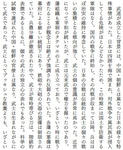According to
"Comparison of social systems in East Asia
and characters of martial arts in Japan,China,Korea"
東アジア社会の比較と、日中朝の武術の特徴
Professor Uozumi Takashi
International Budo University
China

China had 2 types of martial arts.
One was Army martial arts, the other one was Folk martial arts.
Martial arts were brought to Army during Ming
period while they were attacked by nomads in north and pirates in south.
any schools(門派) of 拳(hand) 槍(spear) 棍(stick) were born from Fork martial arts.
Martial arts manuals were written by military officers.

Eventhough Folk martial arts were banned during Qing period, the 3 martial arts were developed to be like professional performing arts or
Taoism style fitness.
Some minority tribes had their own martial arts but the arts didn't spread outside of the tribes or the regions.

When Wako pirates were tense Ming tried to learn Japanese sword arts but it went nowhere because of development of gun and canon,
And Japanese 2 handed sword style wasn't useful in cavalry which Qing Army emphasized.
Sword arts were almost gone except for the ones that some small tribes have had.
Korea

Traditional martial art schools like what China and Japan had weren't found in Korea.
Muye dobo tongji(1790) was the almost only martial art book.
The book is oftenly used for comparative martial arts however establishment process of the book was complicated, it is necessary to be skeptical whether the book said was legit martial arts of the 3 countries or not.

The sort of "Korean traditional martial arts"
we see today are based on Muye dobo tongji.
The book was based on translation of Chinese books and took comlicated process to complete.
The book came out 200 years after they felt necessity of martial arts(Imjin war) , and the book was still based on translation, made by King's order.
The book has been the only "traditional" martial arts texts.
It means Korea didn't develope own martial art.

Yangban system which consisted civillian officials and military officials was established in Joseon period. But civilian officials were always higher than military official under the strong ideology of Confucianism which disrespected military.
Therefore martial art wasn't much developed.
Japan

Ruling class in Japan was military people, martial arts were highly respected.
Martial arts developed as a part of culture under the militaristic society.
In the 16th century, matchlock guns were mass-produced soon after it was brought which changed the form of battles.
Sword art schools were born when sword arts lost its practicality.

Many schools were born during Sengoku period included Bow, Horse riding, Sword, Spear, Naginata, Jujutsu, and Swimming.
Early years of the martial arts were practical and systemized to be schools but they became ways to form character as Samurai in the 17th century.
Not just a skill but Samurai's way of life which was "Budo"

The background of establishment of Budo was Japan had different circmsutances than China and Korea.
Japan was surrounded by sea, there was almost no chance to get invaded by aliens.
There's no national defence forces, soldiers were fighting in civil wars.
Wars in Japan were traditionaly indivisual Samurai's war.
Samurai gained power by arms so Han system was established under military system, Samurai had to be always ready for war.
The swords Samurai always carry were symbol of the social rank and also their independent mind.
Samurai was Samurai since they were born unlike Chinese and Korean bureaucrats who were selected by examinations.

Martial art manuals were written by martial artists.
There's no government made manual.
The school martial arts weren't unified, never used for soldier training directly.

The importance of sword arts was not practical but for strong intentionality of indivisual Samurai's art under Pax Tokugawa.
The role of Martial art culture was to make Samurai form personality as Samurai.
PR
http://ninjer.blog.shinobi.jp/uriginal%20issue/korea%20didn-t%20develope%20ownKorea didn't develope own martial art. Academic research.

